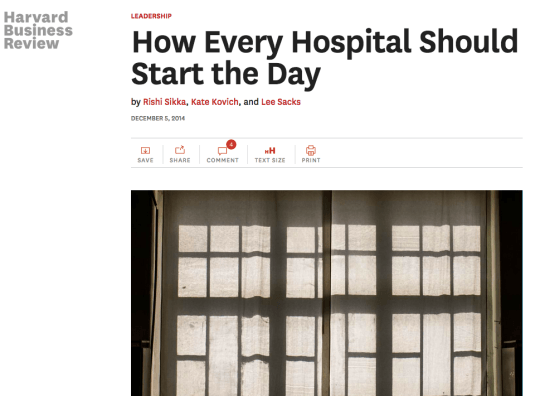Following up on yesterday's post on seemingly successful experiments with ACOs, here's another article, from HBR, on “safety huddles” in healthcare:
“How Every Hospital Should Start the Day“

I've seen some hospitals using daily safety huddles. It sends a powerful message when leaders make patient safety (and staff safety) a visible priority in the organization. Recently, I learned about how ThedaCare does a daily safety huddle (including weekends) via a conference call that ties in leaders from multiple hospitals.
A safety huddle, or starting every meeting with safety as a topic, can't be just about talk — it has to lead to follow up actions that improve safety. Leaders need to create a culture where safety truly is a priority and they need to make it safe, first, for people to speak up about risks or concerns. ThedaCare does a good job of following these principles, of getting beyond talk.
From the HBR post:
“In the spring of 2013, Advocate Health Care, one of the largest U.S. health systems, banished all meetings between 7:00 AM and 9:00 AM and instead instituted mandatory hospital-wide leadership “huddles” to discuss safety issues. Most of these huddles take just 15 minutes and allow hospital leaders to develop situational awareness — a collective understanding of the state of operations — and report and anticipate safety events such as falls, medication errors, and delays in care. With the introduction of huddles, reports of safety events across Advocate's 12 acute-care hospitals increased by 40% (indicating improved detection) as staff members responded to leaders' commitment to safety and transparency, while safety events have continued to dramatically decrease. Problems that were previously unknown or unresolved are now addressed in a day or two under the direction of the hospital president. Today, huddles occur seven days a week, 365 days a year.”
That's a very common dynamic at first:
- Reports go UP (as people are being more open and honest)
- Actual events go DOWN (as problems get resolved and future harm is prevented)
The HBR article talks about how the huddles are often led by the president or CEO. They use terminology that I've heard… calling something a “good catch” instead of a “near miss” because good catch sounds more positive. I've been fine with “near miss” (it's a statement of fact) but maybe that's my engineer brain.
Here is an eight-minute video that's described as being used in safety huddle training. If you bear with the initial silent PowerPoint, there's actual video that shows a huddle taking place.

In the video, you hear leaders talking about patient safety events that had occurred and pointed out risks and things for people to aware of.
Advocate Healthcare, like ThedaCare, has a two-hour “no meeting zone” each morning which frees up time for leaders to go to the gemba and gather information that's needed for the huddles.
Advocate started, in I guess what could be called an experiment, with huddles on weekdays and, because the huddles were so well received, they were expanded to weekend days. Patient safety and the need for it takes no days off!
Listen to Mark read this post (learn more):
Safety Huddles at Mary Greeley Medical Center
I also reached out to some leaders at Mary Greeley Medical Center in Iowa, where I have observed a safety huddle.
Their CEO Brian Dieter said, the “items of greatest benefit from our huddles” are:
- Far better understanding of challenges in both clinical and support roles.
- Including employee safety as well as patient safety was an important early win.
- Greater communication and the occasional “crowd-sourcing” of solutions.
- Cascade of communication happens much more quickly now.
He adds:
“If someone is thinking of beginning this practice, they need to give it a chance and make it a visible commitment. We stand up… it lasts 15 minutes each day. At first, leaders struggled to talk about things about which we didn't know the full details. Now, that is becoming the norm.”
You can see a video of Brian talking about their improvement approaches via KaiNexus.
Karen Kiel-Rosser, their chief quality officer added:
“Our huddles are three-tiered. They start at the bedside with shift to shift report, then proceed to the department huddle, and then on to the organizational / management huddle. This promotes the full circle of patient and employee safety issues being brought forth real-time.”
Here's a video interview with Karen, again via KaiNexus, and my podcast with her on Mary Greeley's Baldrige journey. And, you can read (or listen to) a bonus story that Karen told about truly putting patient safety first.
Is your organization using safety huddles? If so, what are your key lessons learned? If not, what would it take to get your CEO and senior leaders directly engaged in safety improvement, even if it's just an initial small experiment?
What do you think? Please scroll down (or click) to post a comment. Or please share the post with your thoughts on LinkedIn – and follow me or connect with me there.
Did you like this post? Make sure you don't miss a post or podcast — Subscribe to get notified about posts via email daily or weekly.
Check out my latest book, The Mistakes That Make Us: Cultivating a Culture of Learning and Innovation:









I am convinced we could solve a lot of the “herding cats” problems we run into in law firms if lawyers would have “client huddles” or “service huddles” every day. Or even every week…or, let’s face it, if they got together at any time to talk openly about how matters were flowing through their practice groups. Although safety isn’t an issue, Mr. Dieter’s three other benefits translate directly into law. Thanks for the post!
K.
At first I thought the common ground in all these situations was executive commitment. However, the more I think about it, the executive portion is really not required. Anyone can commit to making these results into a reality – even if the results only affect their functional workgroup. It’s human nature to wait for leaders to implement solutions like a safety huddle, but in fact, everyone has the ability to enact this type of change. Great post.
Thanks for the comment, Jeff. I see your point that a department could start doing safety huddles. That might help locally.
But, there are some situations that have to be escalated to more senior leadership… and having the sequential multi-level huddles allows senior leaders to help see broader themes or trends.
That said, the solutions for these problems are generally not going to come from the executives… but we might need their support or they might need to help commit resources in some situations.
Novant Health had been successfully doing safety calls for some time now and as you stated, information is cascaded much quicker, and the call involved not only acute care but ambulatory care, which ensures that we give all of our patients a remarkable experience at every level, every day, every time.
[…] on the topic of safety huddles at […]